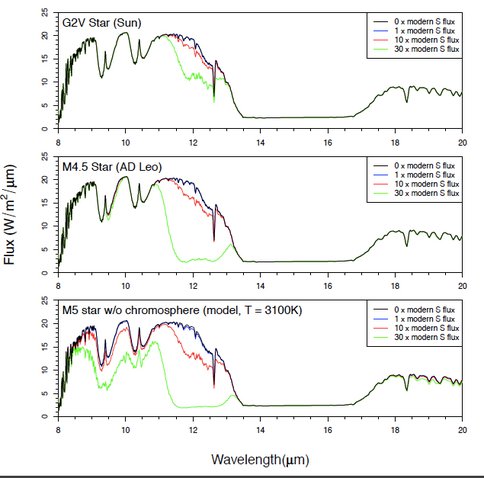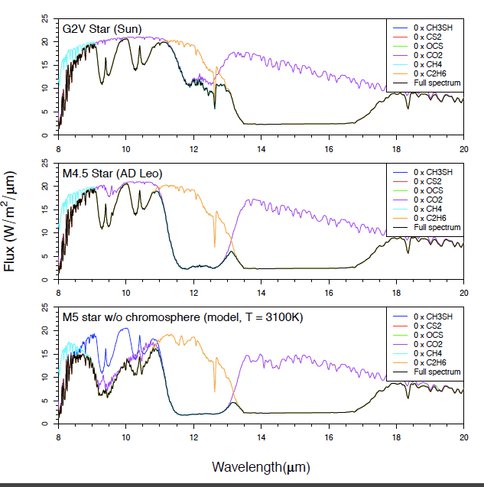2009 Annual Science Report
 VPL at University of Washington
Reporting | JUL 2008 – AUG 2009
VPL at University of Washington
Reporting | JUL 2008 – AUG 2009
Detectability of Biosignatures
Project Summary
This goal of this project is to study our ability to remotely detect life on planets. Primarily, this applies to extrasolar planets – those that exist outside our solar system. The way we will search for life on these planets is by attempting to detect gases produced by life. For example, we could detect the life on modern-day Earth if we detected gases the presence of molecular oxygen (O2, the gas we breathe that is produced by plants and bacteria) and methane (CH4, which is produced by bacteria). These two gases can co-exist only with production rates so high that they are unsustainable without the presence of life on the planet.
Project Progress
During the past year, we have researched remotely detectable biosignatures for anoxic biospheres. This type of biosphere is known to have existed for approximately a third of the history of life on Earth, yet before this work no known biosignatures existed for this type of planet. We modeled the concentrations and spectral features of the following biogenic Sulfur gases: methyl mercaptan (CH3SH), dimethyl sulfide (DMS, CH3-S-CH3), dimethyl disulfide (DMDS, CH3-S-S-CH3), carbon disulfide (CS2), and carbonyl sulfide (OCS). We predict detectable features from CH3SH on planets orbiting M-dwarfs and that have biological CH3SH fluxes that are ~ 30x that on modern-day Earth. The two figures attached to this report show the results from this work. The first shows the spectra for planets with 0, 1, 10, and 30 times the modern-day Earth’s biogenic fluxes of the biogenic S gases. The second figure re-plots the spectra with 30 times the modern-day flux, along with sensitivity tests that remove the spectral effects of gases one by one; the regions on this graph where the “full spectrum” deviates from one of the sensitivity spectra for a particular gas indicate absorption features in that region caused by that gas. From these diagrams, we conclude that CH3SH is the only biogenic sulfur gas with a detectable absorption feature in this wavelength region, and that this feature is only detectable on planets that have at least 30 times the modern-day biogenic S flux and also are in orbit around M-dwarfs. We are currently examining the climatic impacts of such climates.
This figure shows synthetic spectra for planets around the Sun, AD Leo, and a model M-dwarf star without any chromosphere and thus no stellar activity. For each star, we simulate a surface with 0, 1, 10, and 30 times the modern-day biological S gas flux. None of the spectra deviate significantly from the 0-flux case, with the lone exception of the case with 30-times the modern-day S flux on a planet around the M-dwarf with no chromosphere.
This figure shows the gases responsible for the different absorption features seen in Figure 1. The black line represents a planet with 30 times the modern-day biological S flux. The colored lines each represent the spectra of the same atmosphere with a single gas removed from it. Thus, the line labeled “0 x CH3SH” does not have any spectral features from CH3SH. Note the significant deviation between this line and the “full specturm” line, which suggests an ability to remotely detect CH3SH production.
Publications
-
Des Marais, D. J., Nuth, J. A., Allamandola, L. J., Boss, A. P., Farmer, J. D., Hoehler, T. M., … Spormann, A. M. (2008). The NASA Astrobiology Roadmap. Astrobiology, 8(4), 715–730. doi:10.1089/ast.2008.0819
- Boss, A., Young, E., Meadows, V. & Haghighipour, N. (2009). Achieving the Goals and Objectives of the 2008 NASA Astrobiology Roadmap. Astro2010: The Astronomy and Astrophysics Decadal Survey, Science White Papers, 21. doi:2009astro2010S..21B
- Domagal-Goldman, S., Kasting, J. & Meadows, V. (2008). Examining the Ability of Sulfur-Bearing Gases to act as Biosignatures on Anoxic Planets. AGU Fall Meeting 2008. San Francisco.
- Meadows, V. (2009). Remote Detection of Planetary Habitability and Life (Abstract). International Astronomical Union – XXVIIth General Assembly. Rio de Janeiro, Brazil.
- Meadows, V.S., Claire, M.W., Domagal-Goldman, S.D., Allen, M., Anbar, A.D., Barnes, R., Boss, A., Kasting, J., Kiang, N., Martin-Torres, J., Robinson, T.D., Sleep, N., Som, S., Sparks, W. & Williams, D.M. (2009). The Search for Habitable Environments and Life in the Universe. Astro2010: The Astronomy and Astrophysics Decadal Survey, Science White Papers, 201.
-
PROJECT INVESTIGATORS:
-
PROJECT MEMBERS:
Mark Claire
Co-Investigator
James Kasting
Co-Investigator
Victoria Meadows
Co-Investigator
Thangasamy Velusamy
Co-Investigator
Jacob Haqq-Misra
Doctoral Student
Noe Khalfa
Undergraduate Student
-
RELATED OBJECTIVES:
Objective 1.1
Formation and evolution of habitable planets.
Objective 1.2
Indirect and direct astronomical observations of extrasolar habitable planets.
Objective 4.1
Earth's early biosphere.
Objective 6.2
Adaptation and evolution of life beyond Earth


